| |
Warning Order |
| |
|
Navy SEAL Training at SPECWAROPS is open to all U.S. applicants. Applications are accepted from men and women who are 49 years old or less. You may request an age waiver; however, age waivers are reviewed on a case by case basis. Once accepted to the program, each student must pass Phase I in order to proceed to other phases of training; no exceptions.
Navy SEAL Training is equally demanding of your physical talents as your intellect. The instructors at SPECWAROPS suggest that you arrive possessing the physical ability to undergo initial training. The goal at SPECWAROPS is to teach our students real-world skills from real-world operators in a real-world environment.
RUNNING: The majority of the physical activities you will be required to perform during all phases of Navy SEAL Training will involve running. Swimming, bicycling, and lifting weights will prepare you for some of the activities at SPECWAROPS, but ONLY running can prepare your lower extremities for the majority of the activities and overstress injuries that running can cause trainees who arrive not physically prepared to handle it.
The goal of the future Navy SEAL Training student is to work up to 12 miles per week of running. For students that have never or have not recently been on a routine PT program, this requires a nine week buildup program. Follow the workout as best you can and you will be amazed at the progress you will make.
|
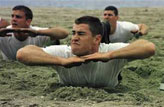 |
| |
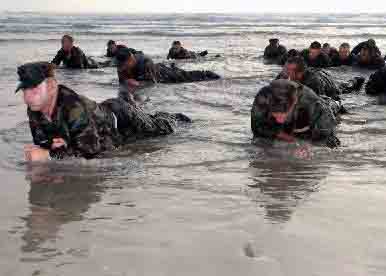 |
| |
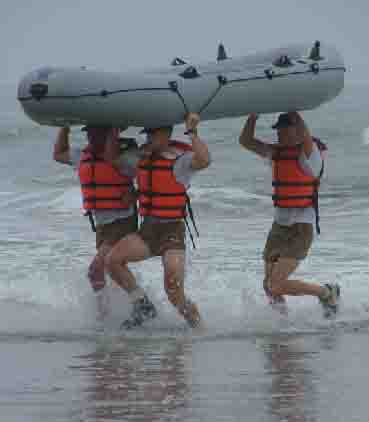 |
| |
|
RUNNING |
|
| |
|
| WEEK # 1: |
1 mile/day, 8:30 pace, M/W/F |
| |
(3 miles/week) |
| WEEK # 2: |
No running. High risk of stress fractures. |
| WEEK # 3 & 4: |
2 miles/day, M/W/F |
| |
(6 miles/week) |
| WEEK # 5 & 6: |
3 miles/day, M/W/F |
| |
(9 miles/week) |
| WEEK # 7 & 8: |
2/3/4/1 miles, M/Tu/Th/F |
| |
(10 miles/week) |
| WEEK # 9: |
4 miles/day, M/W/F |
| |
(12 miles/week) |
|
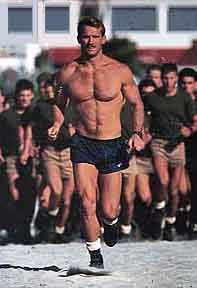 |
| |
|
| Note: It is very important to run in a good pair of running shoes. |
|
| |
|
PHYSICAL TRAINING |
|
| |
|
For a complete body workout and introduction to the exercises you will see in Phase I, we recommend purchasing Scott Helvenston's Navy SEAL Training Camp "Strength" video. (This workout routine is also included on the DVD.) It is an excellent PT routine and will effectively prepare you for Navy SEAL Training. For those who prefer a more basic PT program, the following program will adequately prepare you for Phase I. |
 |
| |
|
| (Mon/Wed/Fri) |
|
|
| WEEK # 1: |
3 sets of 8 PUSH-UPS |
| |
3 sets of 8 SIT-UPS |
| |
2 sets of 3 PULL-UPS |
| WEEK # 2: |
3 sets of 10 PUSH-UPS |
| |
3 sets of 10 SIT-UPS |
| |
3 sets of 3 PULL-UPS |
| WEEK # 3 & 4: |
4 sets of 10 PUSH-UPS |
| |
4 sets of 10 SIT-UPS |
| |
3 sets of 4 PULL-UPS |
| WEEK # 5 & 6: |
3 sets of 15 PUSH-UPS |
| |
3 sets of 15 SIT-UPS |
| |
3 sets of 5 PULL-UPS |
| WEEK # 7 & 8: |
4 sets of 15 PUSH-UPS |
| |
4 sets of 15 SIT-UPS |
| |
2 sets of 8 PULL-UPS |
| WEEK # 9: |
4 sets of 20 PUSH-UPS |
| |
4 sets of 20 SIT-UPS |
| |
3 sets of 8 PULL-UPS |
|
 |
| |
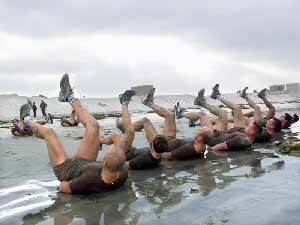 |
| |
|
| Note: For best results, alternate exercises. Do a set of push-ups, then a set of sit-ups, followed by a set of pull-ups, immediately with no rest. |
|
| |
|
SWIMMING |
|
| |
|
| (swim with no fins 2-3 days a week) |
|
|
|
| WEEKS # 1 & 2: |
Swim continuously for 5 min. |
| WEEKS # 3 & 4: |
Swim continuously for 10 min. |
| WEEKS # 5 & 6: |
Swim continuously for 15 min. |
| WEEKS # 7 & 8: |
Swim continuously for 10 min. |
| WEEKS # 9: |
Swim continuously for 15 min. |
|
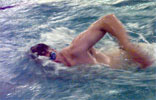 |
| |
|
| Note: If you have access to a pool, swim every day available. Two to three days a week and 200 meters in one session is your initial workup goal. Also, you want to develop your sidestroke, on both the left and the right side. Try to swim 50 meters in one minute or less. |
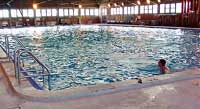 |
| |
|
STRETCHING |
|
| |
|
| Since Mon/Wed/Fri are devoted to PT, it is wise to devote at least 20 minutes on Tue/Thu/Sat to stretching. You should always stretch for at least 15 minutes before any workout. Additionally, just stretching the previously worked muscles will make you more flexible and less likely to get injured. A good way to begin stretching is to start at the top and work your way down. Stretch to tightness, not to pain; hold for 10-15 seconds. DO NOT BOUNCE. Stretch every muscle in your body from the neck to the calves, concentrating on your thighs, hamstrings, chest, back, and shoulders. |
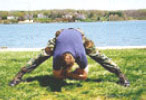 |
| |
|
NUTRITION |
|
| |
|
Proper nutrition is extremely important. You must make sure you receive the necessary nutrients to obtain maximum performance output during exercise and to promote muscle/tissue growth and repair. The proper diet provides all the nutrients for the body's needs and supplies energy for exercise. It also promotes growth and repair of tissue and regulates the body processes.
Carbohydrates, protein, and fat are the three energy nutrients. All three can provide energy, but carbohydrates are the preferred source of energy for physical activity. The majority of carbohydrates should come from complex carbohydrate foods that include bread, pasta, rice, potatoes, crackers, cereal, beans, peas, starchy vegetables, and other whole grain or enriched grain products. Fruits are also loaded with carbohydrates. Protein, found in foods such as meat and fish, serves as building blocks for muscles. During training, more than four servings of these food groups should be consumed daily. If you are trying to slim down prior to arriving at Navy SEAL Training, try to reduce the amount of carbohydrates you eat and increase the amount of protein.
Water is the most important nutrient you can put in your body. You should be consuming up to four quarts of water daily. It is very easy to become dehydrated during Navy SEAL Training, so it is extremely important to hydrate yourself. Drink water before you get thirsty!!! Substances such as alcohol, caffeine, and tobacco increase your body's need for water, so, if you are going to drink, do so in moderation! Too much of these substances will definitely harm your body and hinder your performance. Supplemental intake of vitamins, as well, can be beneficial. But, if you are eating a well balanced diet, there is no need to take vitamins.
ADVISORY: Try these PT routines at your own risk. If you are out of shape or have any history of high blood pressure, this kind of strenuous exercise could lead to serious injury or death. Consult your doctor before beginning any exercise program. |
|
 |
|
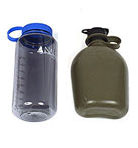 |
| |
|
|
| |
© 2004-2010 S P E C W A R O P S
with questions or comments |
|
|
|

